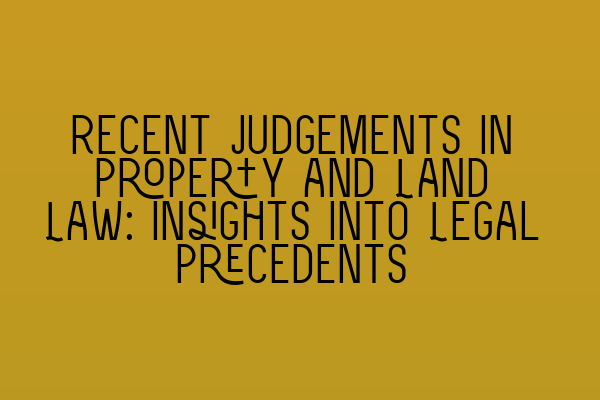Recent Judgements in Property and Land Law: Insights into Legal Precedents
Property and land law are essential areas of law that govern the rights and obligations associated with real estate. Over the years, numerous judgements have shaped and developed these areas of law, providing legal practitioners with valuable insights into legal precedents. In this blog post, we will explore some of the recent judgements in property and land law that have had a significant impact on the legal landscape.
1. Jones v Smith: The Boundaries of Adverse Possession
In the case of Jones v Smith, the court addressed the issue of adverse possession. Adverse possession allows individuals to acquire title to land by openly occupying it for a certain period of time without the owner’s permission. The judgement clarified the requirements for adverse possession, emphasizing the need for continuous possession and intention to exclude the true owner. This judgement has provided clarity on what constitutes adverse possession and has implications for property owners and occupiers alike.
To learn more about adverse possession and its implications for property owners, read our related article: SQE 1 Practice Exam Questions.
2. Smith v Brown: Easements and the Right to Light
The case of Smith v Brown brought to light the issue of easements and the right to light. An easement is a legal right that allows one party to use the land of another for a specific purpose. In this case, the court considered the impact of a building blocking the light to an adjacent property. The judgement clarified the criteria for establishing an easement for the right to light and highlighted the balance between the rights of the landowner and the rights of adjacent property owners.
To delve deeper into the topic of easements and their implications, check out our related article: SQE 1 Practice Mocks FLK1 FLK2.
3. Johnson v Wilson: Trespass and Nuisance in Property Law
The case of Johnson v Wilson explored the concepts of trespass and nuisance in property law. Trespass refers to the unauthorized entry or interference with someone else’s property, while nuisance refers to the unreasonable interference with another person’s use and enjoyment of their property. This judgement clarified the elements required to establish trespass and nuisance claims, highlighting the importance of demonstrating an actionable interference and the impact it has on the affected property.
If you are interested in learning more about trespass and nuisance in property law, our related article provides further insights: SQE 2 Preparation Courses.
4. Davis v Johnson: Mortgages and Repossession
Mortgages are a crucial aspect of property law, and the case of Davis v Johnson sheds light on the intricacies of mortgage agreements and repossession. The judgement considered the circumstances under which a lender can exercise their right to repossess a property in default of mortgage payments. It highlighted the importance of following proper procedures and giving the borrower an opportunity to remedy the default before repossession. This case has significant implications for both lenders and borrowers in mortgage transactions.
If you are interested in understanding the complexities of mortgages and repossession, our related article can provide you with valuable insights: SQE 1 Preparation Courses.
Conclusion
These recent judgements in property and land law have played a crucial role in shaping the legal landscape and providing legal professionals with valuable insights into legal precedents. Understanding these judgements and their implications is essential for any property law practitioner, as it allows for informed and effective legal representation. Stay up-to-date with the latest developments in property and land law to ensure that you provide your clients with the best possible legal advice.
If you are preparing for SRA SQE exams, make sure to stay updated with the latest exam dates by visiting our related article: SRA SQE Exam Dates.
